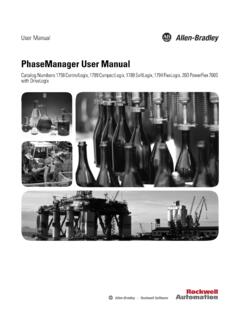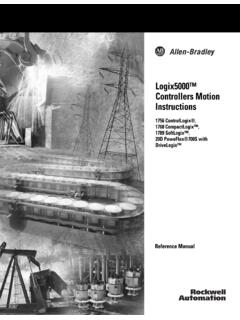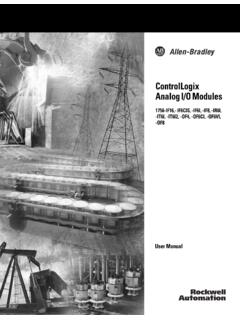Transcription of Logix5000 Controllers Structured Text Programming Manual
1 Logix5000 Controllers Structured TextCatalog Numbers 1756 ControlLogix, 1769 CompactLogix, 1789 SoftLogix, 1794 FlexLogix, PowerFlex 700S with DriveLogixProgramming ManualImportant User InformationSolid state equipment has operational characteristics differing from those of electromechanical equipment. Safety Guidelines for the Application, Installation and Maintenance of Solid State Controls (publication available from your local Rockwell Automation sales office or online at ) describes some important differences between solid state equipment and hard-wired electromechanical devices. Because of this difference, and also because of the wide variety of uses for solid state equipment, all persons responsible for applying this equipment must satisfy themselves that each intended application of this equipment is no event will Rockwell Automation, Inc. be responsible or liable for indirect or consequential damages resulting from the use or application of this examples and diagrams in this Manual are included solely for illustrative purposes.
2 Because of the many variables and requirements associated with any particular installation, Rockwell Automation, Inc. cannot assume responsibility or liability for actual use based on the examples and patent liability is assumed by Rockwell Automation, Inc. with respect to use of information, circuits, equipment, or software described in this of the contents of this Manual , in whole or in part, without written permission of Rockwell Automation, Inc., is this Manual , when necessary, we use notes to make you aware of safety , Rockwell Automation, and TechConnect are trademarks of Rockwell Automation, not belonging to Rockwell Automation are property of their respective information about practices or circumstances that can cause an explosion in a hazardous environment, which may lead to personal injury or death, property damage, or economic information that is critical for successful application and understanding of the information about practices or circumstances that can lead to personal injury or death, property damage, or economic loss.
3 Attentions help you identify a hazard, avoid a hazard, and recognize the consequenceSHOCK HAZARDL abels may be on or inside the equipment, for example, a drive or motor, to alert people that dangerous voltage may be HAZARDL abels may be on or inside the equipment, for example, a drive or motor, to alert people that surfaces may reach dangerous 1756-PM007C-EN-P - October 20093 Table of ContentsTable of ContentsPrefacePurpose of this Manual .. 5 How to Use this Manual .. 5 Chapter 1 Program Structured TextIntroduction .. 7 Assignments .. 9 Specify a Non-retentive Assignment.. 10 Assign an ASCII Character to a String .. 11 Expressions.. 11 Use Arithmetic Operators and Functions .. 13 Use Relational Operators.. 14 Use Logical Operators .. 16 Use Bitwise Operators .. 17 Determine the Order of Execution .. 17 Instructions.. 18 Constructs.. 19 Some Key Words Are Reserved for Future Use .. 32 Comments .. 354 Publication 1756-PM007C-EN-P - October 2009 Table of Contents5 Publication 1756-PM007C-EN-P - October 20095 PrefacePurpose of this ManualThis Manual shows how to program Logix5000 Controllers with the Structured text Programming language.
4 This Manual is one of a set of related manuals that show common procedures for Programming and operating Logix5000 Controllers . For a complete list of common procedures manuals, see the logix 5000 Controllers Common Procedures Programming Manual , publication term Logix5000 controller refers to any controller that is based on the Logix5000 operating system, such as: CompactLogix Controllers ControlLogix Controllers DriveLogix Controllers FlexLogix Controllers SoftLogix5800 controllersHow to Use this ManualSome text is formatted differently from the rest of the that isIdentifiesFor exampleMeansItalicthe actual name of an item that you see on your screen or in an exampleRight-click User-Defined ..Right-click the item that is named information that you must supply based on your application (a variable)Right-click name_of_program ..You must identify the specific program in your application. Typically, it is a name or variable that you have in brackets a keyboard keyPress [Enter].
5 Press the Enter 1756-PM007C-EN-P - October 2009 PrefaceNotes:Publication 1756-PM007C-EN-P - October 20097 Chapter 1 Program Structured TextIntroductionStructured text is a textual Programming language that uses statements to define what to execute. Structured text is not case sensitive. Use tabs and carriage returns (separate lines) to make your Structured text easier to read. They have no effect on the execution of the Structured text is not case sensitive. Structured text can contain these components:TermDefinitionExamplesAssignm ent(see page 9)Use an assignment statement to assign values to := operator is the assignment the assignment with a semi colon ; .tag := expression;Expression(see page 11)An expression is part of a complete assignment or construct statement. An expression evaluates to a number (numerical expression) or to a true or false state (BOOL expression). An expression contains:TagsA named area of the memory where data is stored (BOOL, SINT,INT,DINT, REAL, string).
6 Value1 ImmediatesA constant symbol or mnemonic that specifies an operation within an + tag2tag1 >= value1 FunctionsWhen executed, a function yields one value. Use parentheses to contain the operand of a though their syntax is similar, functions differ from instructions in that functions can only be used in expressions. Instructions cannot be used in (tag1)8 Publication 1756-PM007C-EN-P - October 2009 Program Structured Text Chapter 1 Instruction(see page 18)An instruction is a standalone instruction uses parenthesis to contain its on the instruction, there can be zero, one, or multiple executed, an instruction yields one or more values that are part of a data the instruction with a semi colon ; .Even though their syntax is similar, instructions differ from functions in that instructions cannot be used in expressions. Functions can only be used in ();instruction(operand);instruction(oper and1, operand2,operand3);Construct(see page 19)A conditional statement used to trigger Structured text code ( , other statements).
7 Terminate the construct with a semi colon ; . (see page page 35)Text that explains or clarifies what a section of Structured text does. Use comments to make it easier to interpret the Structured text. Comments do not affect the execution of the Structured text. Comments can appear anywhere in Structured (*start of comment .. end of comment*)/*start of comment .. end of comment*/TermDefinitionExamplesIMPORTANT Use caution when copying and pasting components between different versions of RSLogix 5000 Programming software. RSLogix 5000 software only supports pasting to the same version or newer version of RSLogix 5000 . Pasting to a prior version of RSLogix 5000 software is not supported. When pasting to a prior version, the paste action may succeed but the results may not be as 1756-PM007C-EN-P - October 20099 Chapter 1 Program Structured TextAssignmentsUse an assignment to change the value stored within a tag. An assignment has this syntax:tag := expression ;where:The tag retains the assigned value until another assignment changes the expression can be simple, such as an immediate value or another tag name, or the expression can be complex and include several operators and/or the tag that is getting the new tag must be a BOOL, SINT, INT, DINT, or REAL.
8 :=Is the assignment the new value to assign to the tag is this data typeUse this type of expressionBOOLBOOL expressionSINTINTDINTREALN umeric expression;Ends the module data updates asynchronously to the execution of logic. If you reference an input multiple times in your logic, the input could change state between separate references. If you need the input to have the same state for each reference, buffer the input value and reference that buffer 1756-PM007C-EN-P - October 2009 Program Structured Text Chapter 1 Specify a Non-retentive AssignmentThe non-retentive assignment is different from the regular assignment described above in that the tag in a non-retentive assignment is reset to zero each time the controller : enters the Run mode. leaves the step of an SFC if you configure the SFC for Automatic reset. (This applies only if you embed the assignment in the action of the step or use the action to call a Structured text routine via a JSR instruction.)A non-retentive assignment has this syntax:tag [:=] expression ;where:ComponentDescriptiontagRepresents the tag that is getting the new tag must be a BOOL, SINT, INT, DINT, or REAL.
9 [:=]Is the non-retentive assignment symbolexpressionRepresents the new value to assign to the tag is this data typeUse this type of expressionBOOLBOOL expressionSINTINTDINTREALN umeric expression;Ends the 1756-PM007C-EN-P - October 200911 Chapter 1 Program Structured TextAssign an ASCII Character to a StringUse the assignment operator to assign an ASCII character to an element of the DATA member of a string tag. To assign a character, specify the value of the character or specify the tag name, DATA member, and element of the add or insert a string of characters to a string tag, use either of these ASCII string expression is a tag name, equation, or comparison. To write an expression, use any of these elements. Tag name that stores the value (variable) Number that you enter directly into the expression (immediate value) Functions, such as: ABS, TRUNC Operators, such as: +, -, <, >, And, OrAs you write expressions, follow these general rules. Use any combination of upper-case and lower-case letter.
10 For example, these three variations of AND are acceptable: AND, And, and. For more complex requirements, use parentheses to group expressions within expressions. This makes the whole expression easier to read and ensures that the expression executes in the desired is OKThis is not [0]:= 65; [0] := A; [0]:= [0];string1 := string2;ToUse this instructionAdd characters to the end of a stringCONCAT insert characters into a stringINSERTIMPORTANTYou may add user comments inline. Therefore, local language switching does not apply to your Programming 1756-PM007C-EN-P - October 2009 Program Structured Text Chapter 1In Structured text, you use two types of expressions:BOOL expression: An expression that produces either the BOOL value of 1 (true) or 0 (false). A bool expression uses bool tags, relational operators, and logical operators to compare values or check if conditions are true or false. For example, tag1>65. A simple bool expression can be a single BOOL tag. Typically, you use bool expressions to condition the execution of other expression: An expression that calculates an integer or floating-point value.










